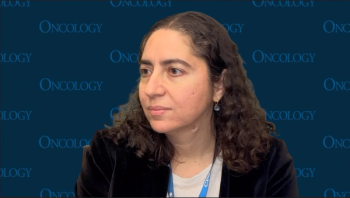
- Oncology Vol 28 No 4
- Volume 28
- Issue 4
Radium-223 vs EBRT for Multiple Painful Bone Metastases: Is Less More?
There is no question that radiopharmaceuticals have a role in the management of patients with metastatic bone disease. There is also no question that fractionated external beam radiotherapy (EBRT) is highly effective and generally well tolerated when delivered with large open or focal fields.
There is no question that radiopharmaceuticals have a role in the management of patients with metastatic bone disease.[1,2] There is also no question that fractionated external beam radiotherapy (EBRT) is highly effective and generally well tolerated when delivered with large open or focal fields.[3] The answer to the question of which form of treatment is preferred should be based on: relative effectiveness, availability, and cost.[4]
It appears that the use of EBRT is largely driven by how far one lives from a radiation center.[4] Thus, it is also likely that whether one lives close to a place where radiopharmaceuticals can be easily obtained would impact patient and physician decisions about the use of such agents. Given the short half-life of radiopharmaceuticals, it is likely that more planning might be required to make use of these agents possible on short notice. In contrast, EBRT can be given the same day the patient arrives and within minutes. In addition, there appears to be a consensus among experts that a single treatment with simple techniques may be preferred in most patients, thus minimizing the need for return visits.[5-7] EBRT is evidence-based and extremely cost-effective when given in short courses.[8,9] For example, in Radiation Therapy Oncology Group (RTOG) 9714, we showed that a single treatment of 800 cGy × 1 was as good as 300 cGy × 10 and more cost-effective in the management of patients with prostate or breast cancer.[10,11] However, despite multiple trials favoring short courses of EBRT, to date expert panels have generally been hesitant to come out strongly for short courses of EBRT, even for prostate cancer.[12,13]
Although several areas can be treated effectively with EBRT, at some point in the spread of a cancer, management would certainly favor the use of radiopharmaceuticals. Another argument for radiopharmaceuticals hinges on whether their use can impact overall survival, as was suggested by one early study and also, more recently, by a study of radium-223.[14,15] Of note, however, in the only head-to-head trial completed to date that I am aware of, the authors concluded that “. . . pain treatment with local field radiotherapy is associated with a better overall survival compared to Strontium (89). The lower costs of local field radiotherapy also favour the use of this treatment in patients with HRPC [hormone-resistant prostate cancer].”[16] However, the study authors noted that the reason for an observed overall survival benefit with local field radiotherapy was not clear. Given that there is no level I evidence to disprove the observed association of an overall survival benefit with EBRT, can we safely ignore these findings? Clearly, clinical judgment will be key to selecting the appropriate modality for a given patient.
Looking forward, a key question will be whether the use of EBRT and radiopharmaceuticals in combination will yield additional benefits over the use of either alone.[17,18] With the promising results noted for radium-223, along with its relatively low toxicity profile, there are reasons to think that there could be a role for its use as an adjunctive therapy in patients with prostate cancer. Such patients might ideally have diffuse bone disease and an excellent performance status but one or two symptomatic lesions involving weight bearing bone(s). It is doubtful, however, that such treatment could displace EBRT, 800 cGy × 1, for a single symptomatic lesion as the standard of care without proof from a large phase III trial.
Financial Disclosure:Dr. Roach receives honoraria from Astellas, AstraZeneca, Bayer, Educational Symposia Inc, Nihon Medi-Physics, Takeda, and Varian Medical Systems; he serves as a consultant to, and on the advisory board of, Ferring Pharmaceuticals and Millennium.
References:
1. Autio KA, Scher HI, Morris MJ. Therapeutic strategies for bone metastases and their clinical sequelae in prostate cancer. Curr Treat Options Oncol. 2012;13:174-88.
2. Zorga P, Birkenfeld B, Listewnik MH, et al. Effectiveness of strontium-89 palliative therapy in patients with painful bone metastases. Ann Acad Med. 2011;57:49-53; discussion 53.
3. Ki Y, Kim W, Nam J, et al. Fractionated wide-field radiation therapy followed by fractionated local-field irradiation for treating widespread painful bone metastasis. Int J Radiat Oncol Biol Phys. 2011;79:220-5.
4. Sutton DS, Kong W, Ding K, et al. The use of palliative radiotherapy for bone metastasis. Radiother Oncol. 2010;97:548-53.
5. Lutz ST, Fairchild A, Chow E, et al. Background, rationale and goals for the 2010 International Consensus Conference bone metastasis treatment workshop. Clin Oncol (R Coll Radiol). 2009;21:649-51.
6. Lutz S, Hoskin P, Chow E. Update on palliative radiotherapy endpoints for bone metastasis trials. Clin Oncol (R Coll Radiol). 2009;21:659-61.
7. Lo SS, Sahgal A, Hartsell WF, et al. The treatment of bone metastasis with highly conformal radiation therapy: a brave new world or a costly mistake? Clin Oncol (R Coll Radiol). 2009;21:662-4.
8. Janjan N, Lutz ST, Bedwinek JM, et al. Therapeutic guidelines for the treatment of bone metastasis: a report from the American College of Radiology Appropriateness Criteria Expert Panel on Radiation Oncology. J Palliat Med. 2009;12:417-26.
9. Janjan N, Lutz ST, Bedwinek JM, et al. Clinical trials and socioeconomic implication in the treatment of bone metastasis: a report from the American College of Radiology Appropriateness Criteria Expert Panel on Radiation Oncology. J Palliat Med. 2009;12:427-31.
10. Hartsell WF, Scott CB, Bruner DW, et al. Randomized trial of short- versus long-course radiotherapy for palliation of painful bone metastases. J Natl Cancer Inst. 2005;97:798-804.
11. Konski A, James J, Hartsell W, et al. Economic analysis of Radiation Therapy Oncology Group 9714: multiple versus single fraction radiation treatment of patients with bone metastases. Am J Clin Oncol. 2009;32:423-8.
12. Expert Panel On Radiation Oncology-Bone M, Lutz ST, Lo SS, et al. ACR Appropriateness Criteria® non-spine bone metastases. J Palliat Med. 2012;15:521-6.
13. Mohler JL, Armstrong AJ, Bahnson RR, et al. Prostate cancer, version 3.2012: featured updates to the NCCN guidelines. J Natl Compr Canc Netw. 2012;10:1081-7.
14. Tu SM, Millikan RE, Mengistu B, et al. Bone-targeted therapy for advanced androgen-independent carcinoma of the prostate: a randomised phase II trial. Lancet. 2001;357:336-41.
15. Brady D, Parker CC, O’Sullivan JM. Bone-targeting radiopharmaceuticals including radium-223. Cancer J. 2013;19:71-8.
16. Oosterhof GO, Roberts JT, de Reijke TM, et al. Strontium(89) chloride versus palliative local field radiotherapy in patients with hormonal escaped prostate cancer: a phase III study of the European Organisation for Research and Treatment of Cancer, Genitourinary Group. Eur Urol. 2003;44:519-26.
17. Smeland S, Erikstein B, Aas M, et al. Role of strontium-89 as adjuvant to palliative external beam radiotherapy is questionable: results of a double-blind randomized study. Int J Radiat Oncol Biol Phys. 2003;56:1397-404.
18. Porter AT, McEwan AJ, Powe JE, et al. Results of a randomized phase-III trial to evaluate the efficacy of strontium-89 adjuvant to local field external beam irradiation in the management of endocrine resistant metastatic prostate cancer. Int J Radiat Oncol Biol Phys. 1993;25:805-13.
Articles in this issue
over 11 years ago
HER2-Positive Breast Cancer: The Story Goes Onover 11 years ago
Diffuse Large B-Cell Lymphoma: One Treatment No Longer Fits Allover 11 years ago
Diffuse Large B-Cell Lymphoma: Changing Treatment Paradigmsover 11 years ago
Large Renal Mass: A Challenge for the UrologistNewsletter
Stay up to date on recent advances in the multidisciplinary approach to cancer.




















































































